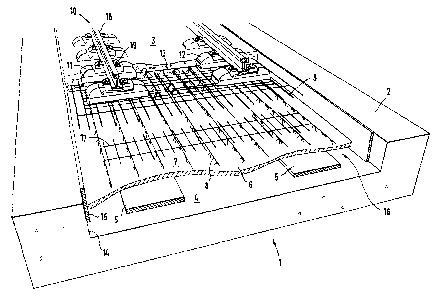Une partie des informations de ce site Web a été fournie par des sources externes. Le gouvernement du Canada n'assume aucune responsabilité concernant la précision, l'actualité ou la fiabilité des informations fournies par les sources externes. Les utilisateurs qui désirent employer cette information devraient consulter directement la source des informations. Le contenu fourni par les sources externes n'est pas assujetti aux exigences sur les langues officielles, la protection des renseignements personnels et l'accessibilité.
L'apparition de différences dans le texte et l'image des Revendications et de l'Abrégé dépend du moment auquel le document est publié. Les textes des Revendications et de l'Abrégé sont affichés :
| (12) Brevet: | (11) CA 2592757 |
|---|---|
| (54) Titre français: | VOIE FIXE POUR VEHICULES FERROVIAIRES |
| (54) Titre anglais: | FIXED TRACK BED FOR RAIL VEHICLES |
| Statut: | Accordé et délivré |
| (51) Classification internationale des brevets (CIB): |
|
|---|---|
| (72) Inventeurs : |
|
| (73) Titulaires : |
|
| (71) Demandeurs : |
|
| (74) Agent: | SMART & BIGGAR LP |
| (74) Co-agent: | |
| (45) Délivré: | 2010-12-07 |
| (86) Date de dépôt PCT: | 2006-10-12 |
| (87) Mise à la disponibilité du public: | 2007-05-24 |
| Requête d'examen: | 2007-07-19 |
| Licence disponible: | S.O. |
| Cédé au domaine public: | S.O. |
| (25) Langue des documents déposés: | Anglais |
| Traité de coopération en matière de brevets (PCT): | Oui |
|---|---|
| (86) Numéro de la demande PCT: | PCT/DE2006/001792 |
| (87) Numéro de publication internationale PCT: | DE2006001792 |
| (85) Entrée nationale: | 2007-07-04 |
| (30) Données de priorité de la demande: | ||||||
|---|---|---|---|---|---|---|
|
L'invention concerne une voie fixe pour véhicules ferroviaires, posée sur des éléments élastiques, la plaque porteuse (3) en béton étant constituée de plaques (6) préfabriquées sur lesquelles une couche de béton est coulée sur site, les plaques préfabriquées reposant sur les éléments élastiques et formant un composite monolithique avec le béton coulé sur site.
Fixed track bed for rail vehicles which is mounted on elastic elements, with
the concrete support plate being composed of prefabricated plate elements
and a layer of local concrete located thereon, with the prefabricated plate
elements resting on the elastic elements and forming a monolithic composite
with the local concrete.
Note : Les revendications sont présentées dans la langue officielle dans laquelle elles ont été soumises.
Note : Les descriptions sont présentées dans la langue officielle dans laquelle elles ont été soumises.

2024-08-01 : Dans le cadre de la transition vers les Brevets de nouvelle génération (BNG), la base de données sur les brevets canadiens (BDBC) contient désormais un Historique d'événement plus détaillé, qui reproduit le Journal des événements de notre nouvelle solution interne.
Veuillez noter que les événements débutant par « Inactive : » se réfèrent à des événements qui ne sont plus utilisés dans notre nouvelle solution interne.
Pour une meilleure compréhension de l'état de la demande ou brevet qui figure sur cette page, la rubrique Mise en garde , et les descriptions de Brevet , Historique d'événement , Taxes périodiques et Historique des paiements devraient être consultées.
| Description | Date |
|---|---|
| Requête visant le maintien en état reçue | 2024-10-01 |
| Paiement d'une taxe pour le maintien en état jugé conforme | 2024-10-01 |
| Représentant commun nommé | 2019-10-30 |
| Représentant commun nommé | 2019-10-30 |
| Lettre envoyée | 2018-05-03 |
| Lettre envoyée | 2018-05-03 |
| Lettre envoyée | 2018-05-03 |
| Lettre envoyée | 2018-05-03 |
| Inactive : Transferts multiples | 2018-04-19 |
| Requête pour le changement d'adresse ou de mode de correspondance reçue | 2018-03-28 |
| Accordé par délivrance | 2010-12-07 |
| Inactive : Page couverture publiée | 2010-12-06 |
| Préoctroi | 2010-09-20 |
| Inactive : Taxe finale reçue | 2010-09-20 |
| Lettre envoyée | 2010-04-06 |
| Un avis d'acceptation est envoyé | 2010-04-06 |
| Un avis d'acceptation est envoyé | 2010-04-06 |
| Inactive : Approuvée aux fins d'acceptation (AFA) | 2010-03-29 |
| Modification reçue - modification volontaire | 2010-01-20 |
| Inactive : Dem. de l'examinateur par.30(2) Règles | 2009-07-20 |
| Lettre envoyée | 2008-04-14 |
| Inactive : Correspondance - Poursuite | 2008-03-20 |
| Inactive : Correspondance - Poursuite | 2008-01-21 |
| Inactive : Page couverture publiée | 2007-09-21 |
| Inactive : Notice - Entrée phase nat. - Pas de RE | 2007-09-19 |
| Inactive : CIB en 1re position | 2007-08-01 |
| Demande reçue - PCT | 2007-07-31 |
| Requête d'examen reçue | 2007-07-19 |
| Toutes les exigences pour l'examen - jugée conforme | 2007-07-19 |
| Exigences pour une requête d'examen - jugée conforme | 2007-07-19 |
| Exigences pour l'entrée dans la phase nationale - jugée conforme | 2007-07-04 |
| Demande publiée (accessible au public) | 2007-05-24 |
Il n'y a pas d'historique d'abandonnement
Le dernier paiement a été reçu le 2010-09-16
Avis : Si le paiement en totalité n'a pas été reçu au plus tard à la date indiquée, une taxe supplémentaire peut être imposée, soit une des taxes suivantes :
Les taxes sur les brevets sont ajustées au 1er janvier de chaque année. Les montants ci-dessus sont les montants actuels s'ils sont reçus au plus tard le 31 décembre de l'année en cours.
Veuillez vous référer à la page web des
taxes sur les brevets
de l'OPIC pour voir tous les montants actuels des taxes.
Les titulaires actuels et antérieures au dossier sont affichés en ordre alphabétique.
| Titulaires actuels au dossier |
|---|
| PCM RAIL.ONE AG |
| Titulaires antérieures au dossier |
|---|
| FRANZ HABAN |
| HEINRICH GALL |
| MARTIN KOWALSKI |